- X (AKA Twitter)
- YouTube
- TikTok
- 1. Define Your Business Goals
- 2. Study Your Audience and Your Competitors
- 3. Create Original Authentic Content in Your Brand’s Voice
- Tools to Make Images and Videos for Social Media
- 4. Go Beyond Posting: Engage in Social Conversations
- 5. Consider B2B Influencer Marketing
- How to Find Marketing Partners with Influencer Analytics:
Social media is one of the most effective ways to build your brand, communicate with your audience, and drive lead generation.
It’s where your brand can establish a personality and a voice that engages directly with the client base.
But how do you establish this personality as a business-to-business (B2B) operation?
We consulted with our in-house social media team on their success with the Semrush brand and compiled this guide to share our knowledge and help you learn from our experience.
Let’s dive in.
Business-to-business social media marketing is the practice of using social media platforms to build networks, develop relationships, and promote products or services to other businesses.
But let’s get one thing out of the way: B2B does not mean boring.
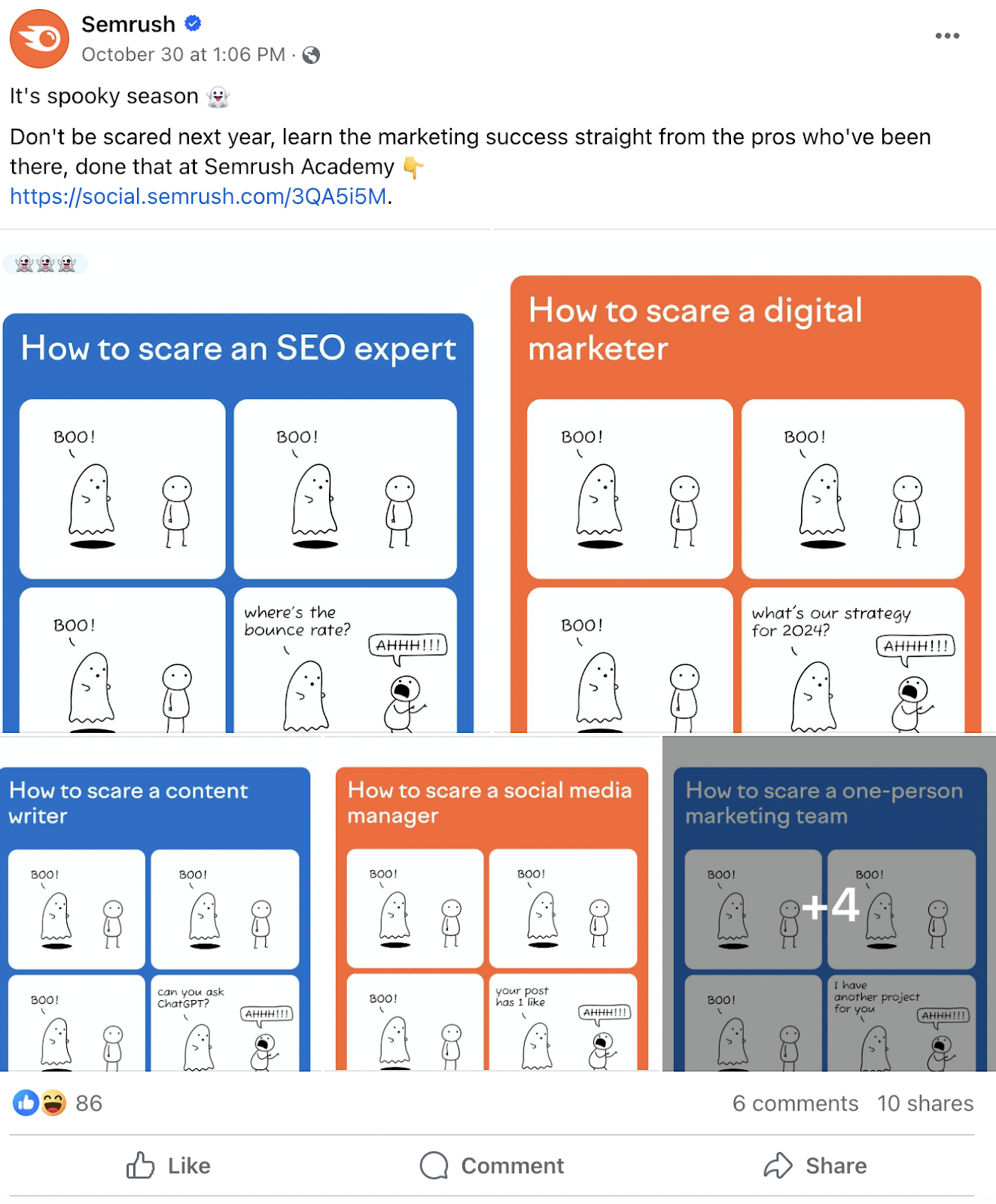
In fact, we advocate the opposite. Social media allows you to move away from dull marketing techniques to more creative and interactive strategies.
Unlike business-to-consumer (B2C) marketing, which often targets quick sales from individual customers, B2B marketing can focus on building long-term relationships and demonstrating knowledge of industry-specific challenges.
By leveraging social media, B2B businesses can create messages that strike a chord, stir emotions, and foster a deeper bond with the audience. This makes your brand an approachable resource that potential clients can relate to and return to.
Take it from us – we’ve grown our audiences on social media from 280,000 to 960,000 over the past four years, and our team has implemented tons of creative and entertaining strategies along the way.
It may seem overwhelming to navigate multiple platforms and engage in numerous conversations.
However, with a well-defined plan, you can generate discussions that go beyond one-sided communication to foster meaningful conversations with your audience.
Globally, there are hundreds of social media platforms to choose from, making it difficult to know where to begin with your marketing strategy.
However, a handful stand out and serve as ideal starting points for your social media endeavors.
LinkedIn is the quintessential B2B social media platform that hosts a professional audience. However, the platform has evolved from a more formal communication style to an engaging tone, with brands offering informative content that’s also entertaining and digestible, all while maintaining brand identity.
This shift from “formal” to engaging reflects a trend towards genuine connection and down-to-earth professional networking content.
Therefore, the tone on LinkedIn should be approachable and engaging while also staying professional. You can blend industry insights, company achievements, and thought leadership with casual and even humorous posts, encouraging relatability and deeper professional relationships.
Talk to your audience as a colleague. Engage them by diving into one pain point in each piece of content. Be generous with valuable info right from the start, and don’t hide too much behind gated content– people appreciate that open approach!
X (AKA Twitter)
Twitter’s fast-paced environment is great for B2B marketers aiming to reach a wide and varied audience. It’s particularly effective for businesses looking to engage with current events and trends.
On Twitter, a more conversational and timely tone works best. Businesses should focus on quick updates, industry news, and timely responses to current events. Engaging directly with other businesses and influencers through retweets and replies is also a key strategy.
According to a survey of global marketers in 2022, Facebook as a whole leans towards B2C. However, this platform can still be a valuable space for B2B marketers. With its diverse audience, you can reach a broader demographic.
The tone on Facebook can be more relaxed and personable, focusing on storytelling and brand personality. Sharing company news, employee spotlights, and behind-the-scenes content can resonate well with the Facebook audience.
One of the benefits of Facebook is the ability to create and manage private groups where you can engage in conversations central to your brand. Here, you have direct access to your customer base and can gain insight through polls, surveys, or Q&As.
In addition, your group members get to talk to other customers of your business, exchange insights on effective strategies, discover new methodologies, and more.
With the Semrush All-Stars group, we have a community of over five thousand active members.
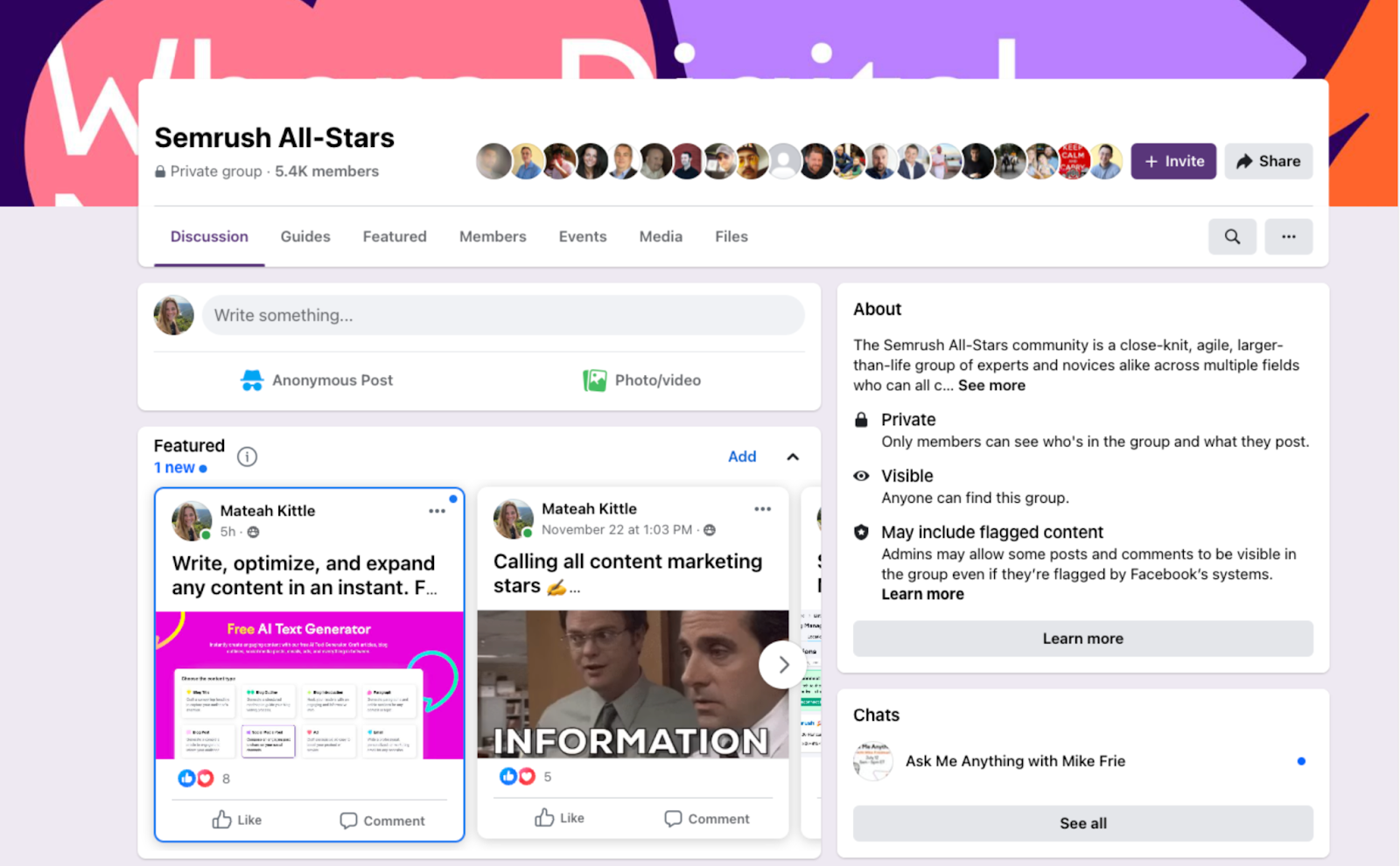
While you could have your brand’s Facebook account present in the group, having a person run and regularly post in a group presents a better opportunity to personify your brand.
Semrush’s Online Reputation and Community Manager, Mateah Kittle, offers the following advice.
When operating a group on a social media platform, you’re still up against the algorithms. You can’t start a community and hope that it will promote itself. You have to show users (and algorithms) why they should want to interact with your content.
Some best practices when managing a group:
- Determine the group’s value proposition for users
- Understand what topics will engage your members
- Decide on membership criteria and access levels
- Organize group admission and segment your customers effectively (e.g., free, freemium, paid, trial)
- Plan strategies for attracting users to the group, such as through emails, onboarding processes, or advertising
For instance, Semrush uses its group to announce product updates, share tool workflows, offer early access, gather product feedback, and facilitate an open question forum.
Instagram is visually driven and can be used effectively for B2B marketing, especially for brands with a robust visual component to their products or services.
On Instagram, high-quality images, short videos, and stories showcasing products, company culture, and visual narratives of business success stories work well.
YouTube
YouTube is one of the most visited websites in the world–and the second biggest search engine. Its extensive reach makes it an excellent platform for in-depth content such as tutorials, product demonstrations, and company announcements.
YouTube supports a variety of voices. In general, yours should be informative and engaging while staying true to your brand.
Since it functions as a search engine, long-form content that educates and provides value to the viewer, such as how-to guides, webinars, and expert interviews, is typically effective. Integrating YouTube keyword research and collaborating with influencers can further amplify your channel’s impact.
TikTok
While originally favored by a younger user base, our team has seen TikTok engage all age ranges equally, making it a versatile spot for B2B marketers who want to hit a broad audience.
B2B marketers can leverage TikTok for short, captivating videos that showcase a more relatable side of their business. Educational content, industry-related humor, and participation in trending challenges can be effective.
To get started, you’ll need your B2B social media marketing strategy, which will outline how you’ll connect with your business clients, amplify your online presence, and improve your bottom line.
Let’s look at a step-by-step business-to-business social media marketing strategy you can follow to connect with your audience and outperform your competitors.

1. Define Your Business Goals
Before diving into social media marketing, define what you want your business to achieve. Your approach doesn’t need to be complex; it simply requires intention.
By defining your goals at the outset, you ensure that every post, like, share, and comment drives you closer to your desired outcome.

Therefore, before embarking on a social media strategy, figure out where this plan will live on the sales funnel. For many, it’s at the top—raising awareness. For others, it’s encouraging middle-of-the-funnel prospects by sharing testimonials, case studies, and webinars.
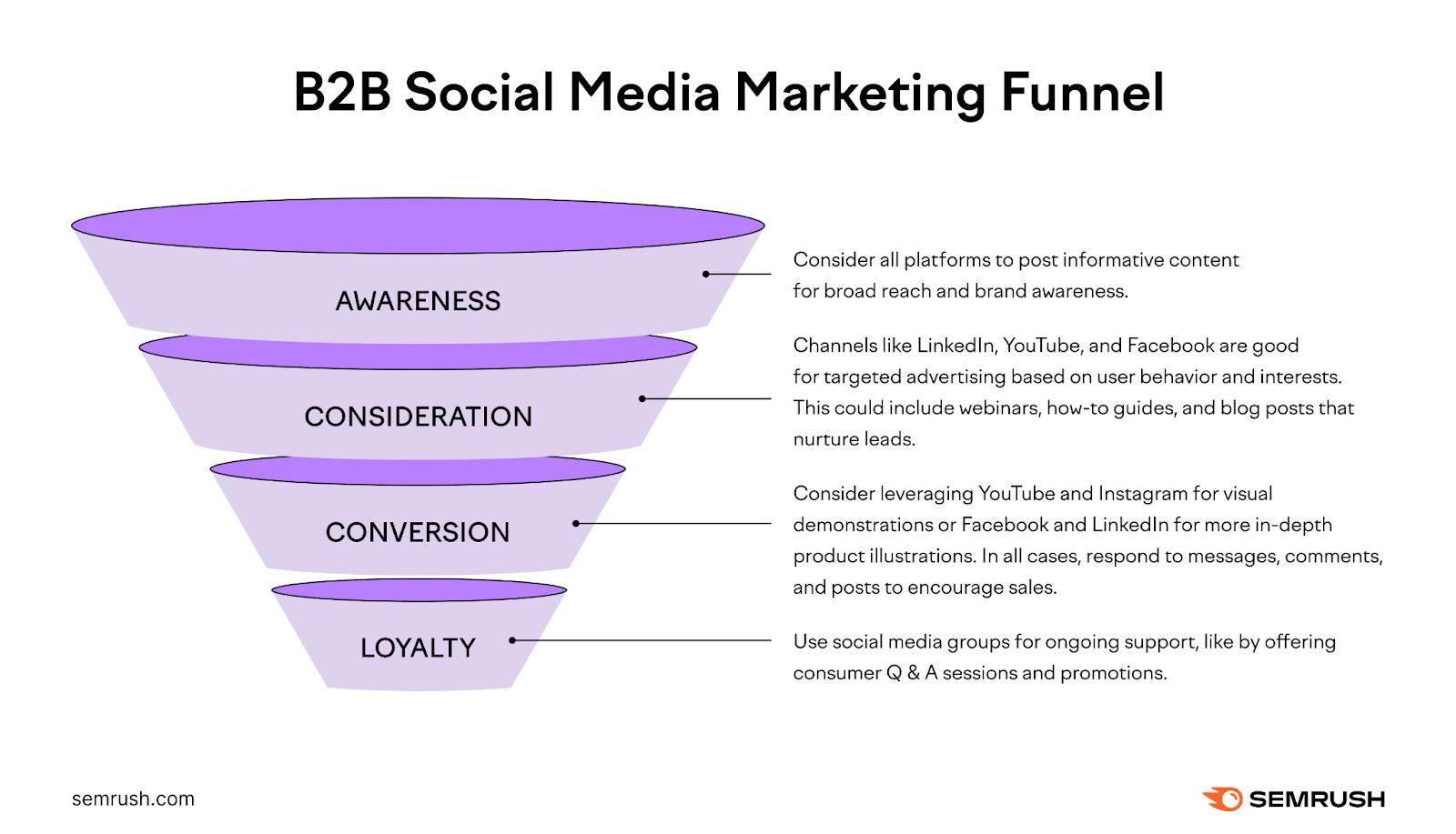
Next, cover your bases by determining who you are trying to reach, what channels they are using, what content you will post, and what tools you will use to facilitate the process.
In the goal-setting stage, the Social Poster in Semrush Social is a great place to start.
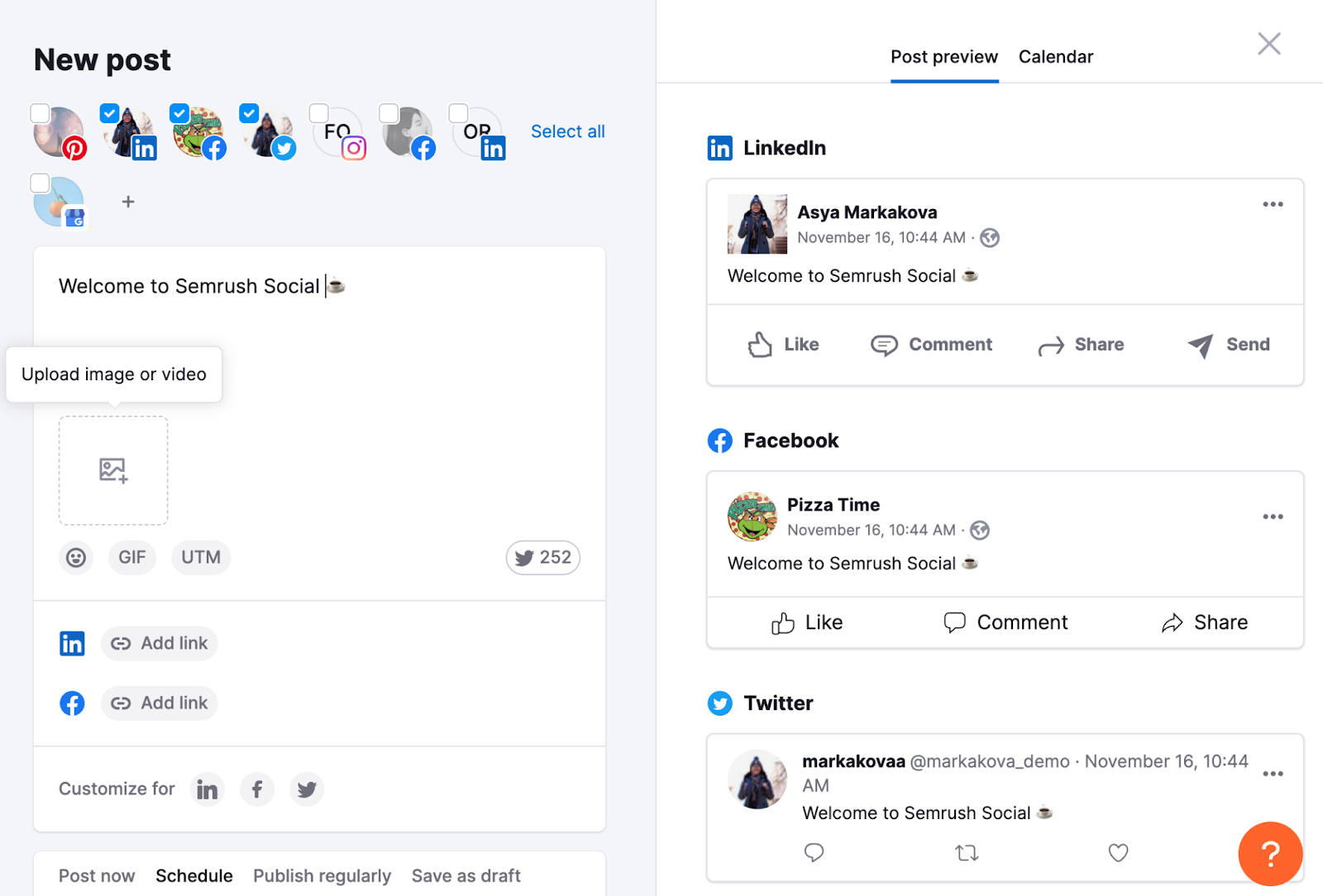
Here, you can draft, schedule, and post content on various social media platforms all in one place. You can also use this tool to generate content ideas for social posts.
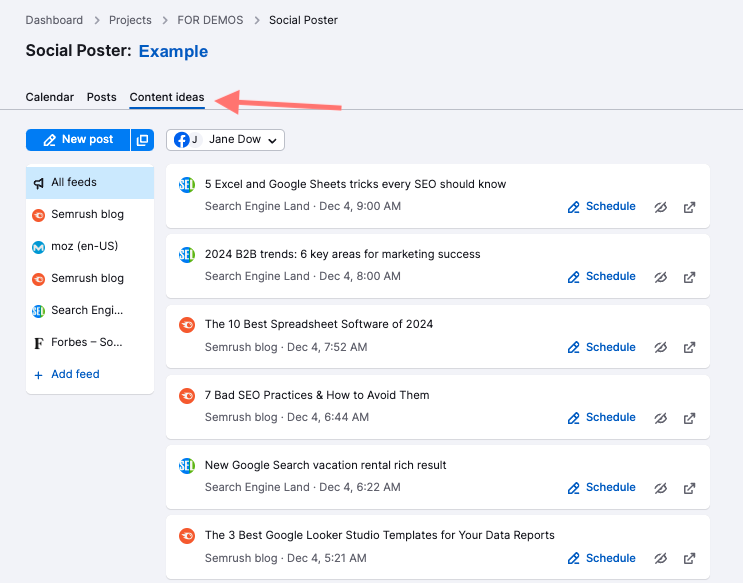
Once you decide what to post, you can monitor it in Social Poster’s calendar view.
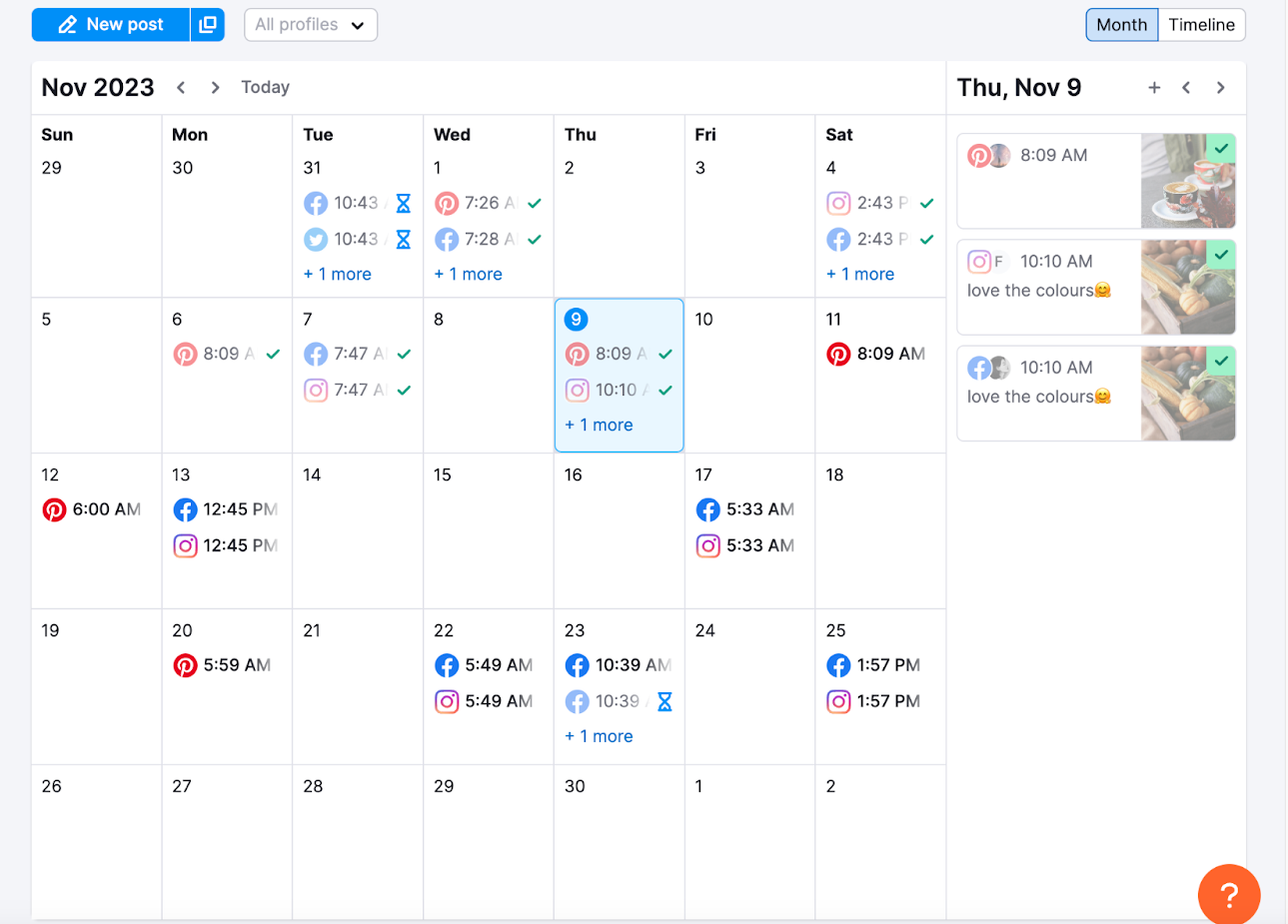
2. Study Your Audience and Your Competitors
It can be assumed that competing B2B companies will have overlapping social media audiences. As a result, by studying both your own audience and your competitors’, you can obtain valuable insights that will shape your strategy.
In addition, analyzing social channels that have engaged audiences, even if they are not your direct competitors, can also inform your strategy.
Fortunately, there are a few free and convenient ways to embark on social media competitor analysis.
To begin, you can gain insight into what might be effective by simply following and observing your competitors’ social media accounts, reading their posts, and taking note of what generates interest.
If you want to take it a step further, you can take advantage of the free platform-specific reports offered by your social media business pages (for example, on Facebook Insights). These reports usually give you a good idea of audience demographics and interests, along with engagement metrics.

If you’re ready for the next level, there are plenty of additional resources available that can help you further understand your target audience.
The Audience Intelligence App in the Semrush App Center allows you to truly understand any social brand’s audience by revealing how they interact with content while online.

This app takes data from social media networks to give you intel on interests, content engagement, online patterns, and purchasing behavior for any social media account you wish to research.
You can review everything from where they spend their time online to personality traits by clicking on any of the categories in the menu bar.
Specifically for social media research, looking at the “Online Habits” report (below) will be insightful.
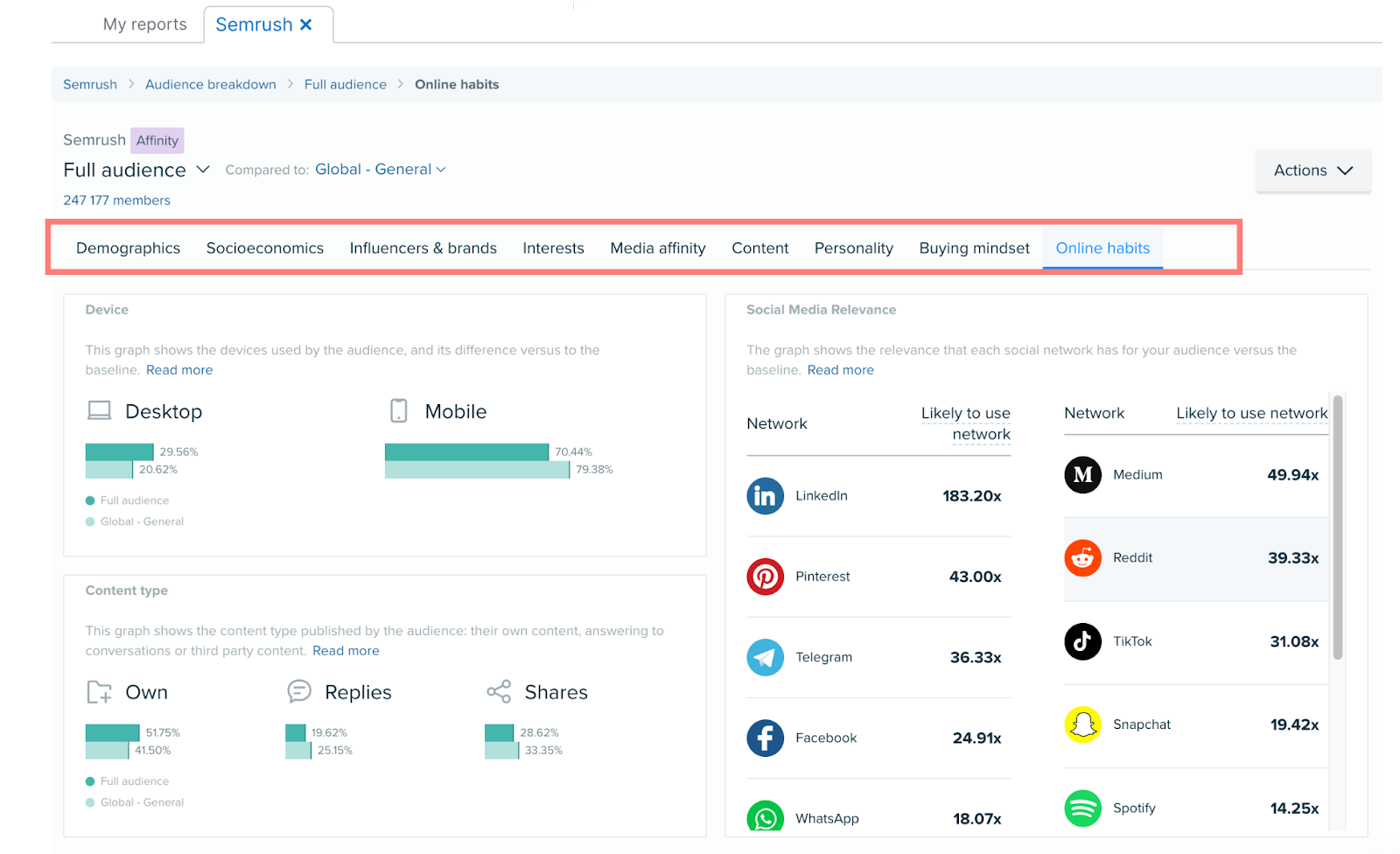
Some questions to consider:
- Do they love how-to videos or infographics?
- Do they dive into or breeze by longer form content?
- Do brands or influencers sway their opinions?
- Are they spontaneous or calculated buyers?
Knowing this lets you hit the mark with your content every time, especially if one of your goals is to influence purchase decisions on your social channels.
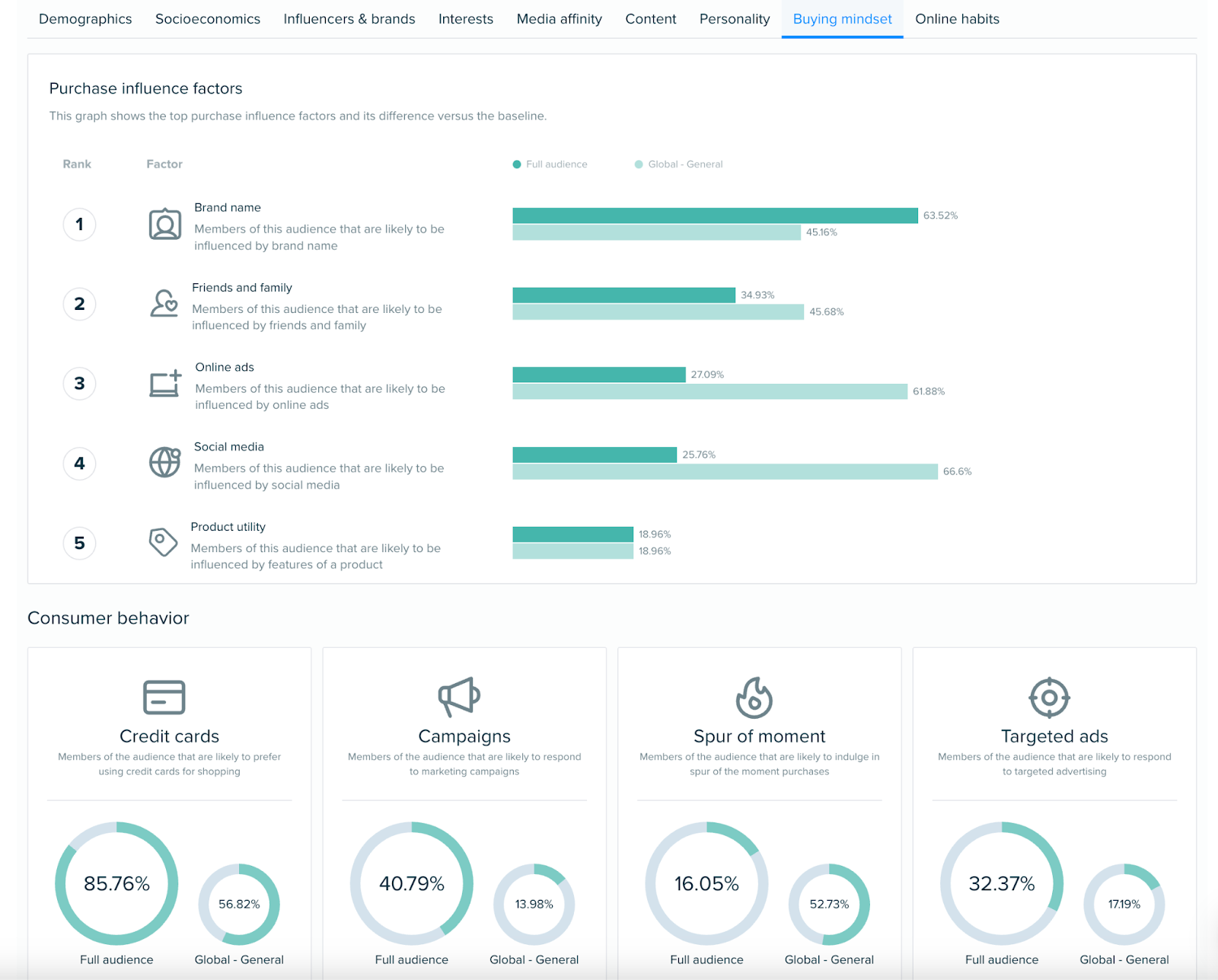
But this isn’t the only app you can use to strengthen your audience knowledge for your B2B social marketing plan.
The Social Tracker lets you track social media accounts across platforms. It enables you to learn from competitor wins and losses and structure your messaging accordingly.
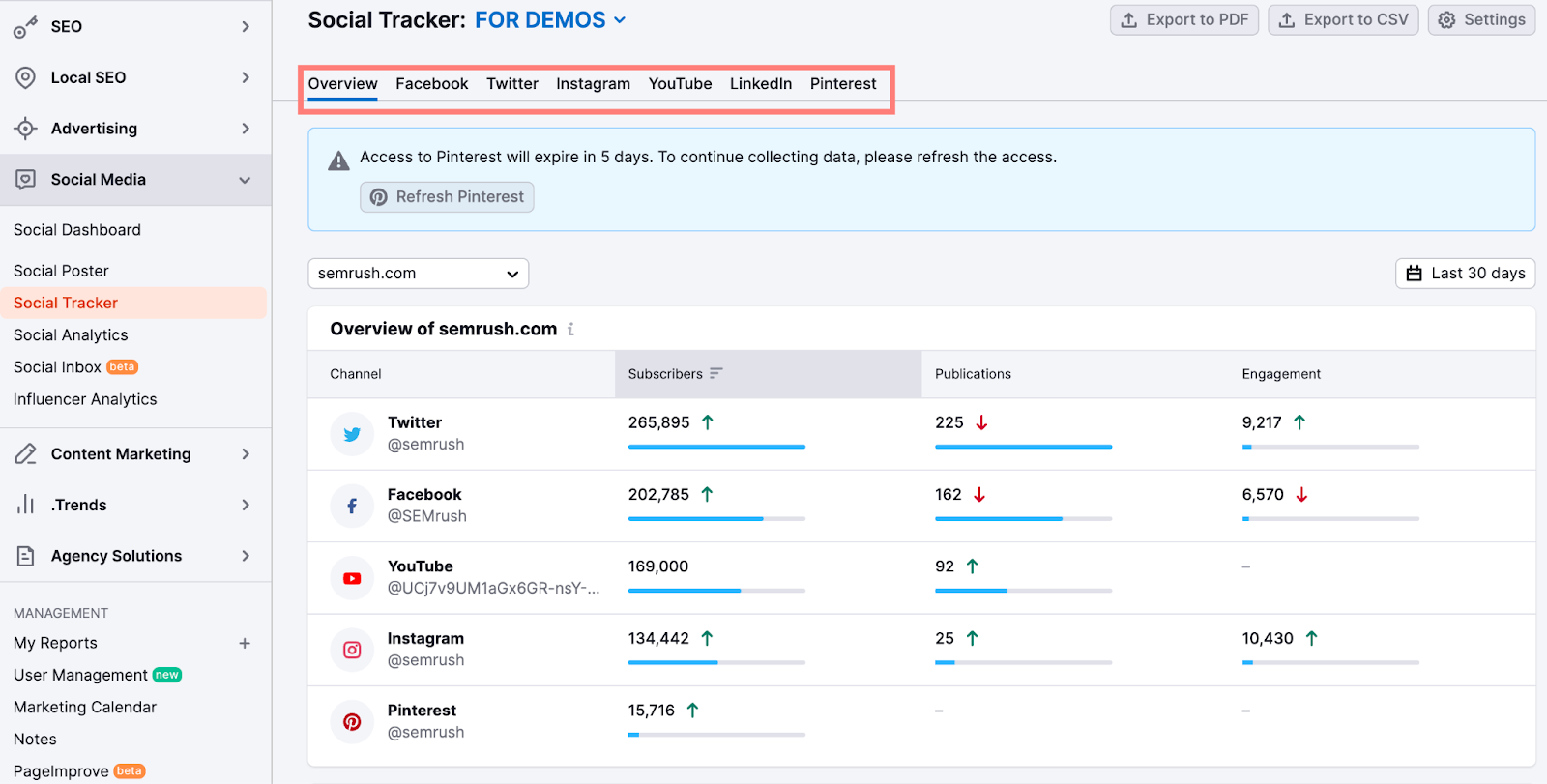
In addition, the reports in Social Tracker offer a convenient method to identify the top-performing content within your particular industry, ensuring you stay updated on the social media preferences of your target audience.
Remember, once you’ve researched your competitors’ strategies, you can use Social Poster to manage your content calendar and write and schedule your posts. Both of these apps fall under Semrush Social and work well together.
Armed with this knowledge, the next step is to channel these insights into developing and distributing unique content that reflects your brand.
3. Create Original Authentic Content in Your Brand’s Voice
After effectively defining your goals, identifying your audience, and reviewing the competition, it’s time to craft your content.
The content you share on social media serves as your brand’s voice, allowing you to tell your story and forge a meaningful connection with your audience. Capturing and maintaining your audience’s attention relies on the quality of your content and how it’s presented.
Consider the following content best practices:
Define Your Messaging:
Start by defining the fundamental messages that reflect your brand’s vision. Focus on clearly articulating what your brand stands for, setting the stage for deeper, more meaningful engagement with your audience.
For example, Semrush’s mission is to provide an all-inclusive online solution, allowing anyone to easily engage in digital marketing. Their marketing efforts across various social media platforms, such as Facebook, YouTube, and X (Twitter), convey this message to the public.
Repurpose Your Content:
To maximize your impact and reach, consider repurposing existing content to fit different social media channels.
For instance, a blog post from your company blog could be repurposed into an infographic with key points, making it ideal for quick distribution across various platforms.
Or, take a YouTube video from your channel and summarize it in a Twitter thread or LinkedIn carousel.
Vary Content Formats:
In social media marketing, the focus has shifted from merely gathering followers to prioritizing interaction. To maintain audience interest, be sure to diversify your content formats.
A mix of sales-focused posts, educational pieces, inspirational content, and informative updates will keep your audience engaged and informed.
Some effective content types include:
Incorporate Video Content:
Videos are a powerful tool in social media marketing, offering a dynamic way to engage your audience.
However, different types of video content, such as explainer videos, product demos, behind-the-scenes looks, and customer testimonials, each provide a different experience.
Historically, making videos has been a time-consuming process.
That’s where having some video-making tools will help.
Tools to Make Images and Videos for Social Media
Some additional tools worth checking out to make your own images and videos for social are:
- AI Social Content Generator:This app lets you create diverse, branded videos, images, and carousels with simple prompts and the help of AI.
- Canva: Canva is a tool for designing social media graphics, presentations, and invitations with a user-friendly interface that makes it easy to create professional-looking content quickly and efficiently.
- Loom: Loom allows you to easily record and share video messages that can be readily distributed on social platforms, fostering engaging content that can connect with social media audiences.
- Giphy: Giphy offers the option to generate personalized GIFs or select from a collection of pre-made animated GIFs, which can add an entertaining element to social media posts.
- Instant video creator: This tool quickly transforms blogs into videos, streamlining the process.
- Instant banner creator: Instant banner creator is a handy tool that quickly creates captivating banners for social media that help establish a lasting impact on platforms, leading to a higher awareness of the brand.
Want to see how these kinds of tools can work? Here’s a quick walkthrough of the AI Social Content Generator.
AI Social Content Generator is segmented into three categories: the Content Library, Competitor Research, and Brand Management.
To get set up, all you need to do is provide brand specifics and a little direction, and the tool will begin generating posts.
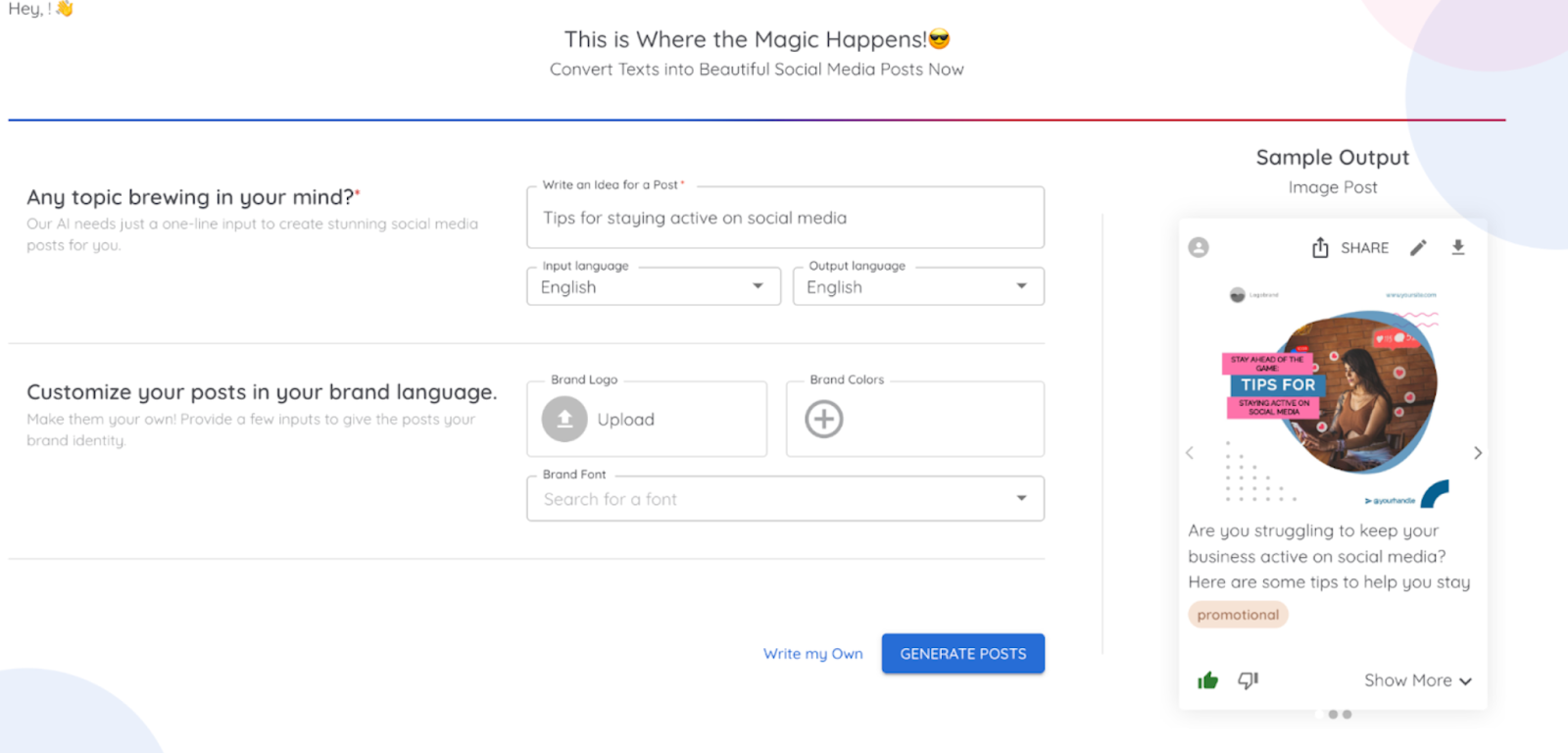
In the Brand Management section, you can organize brand specifics like logos, colors and font preferences.
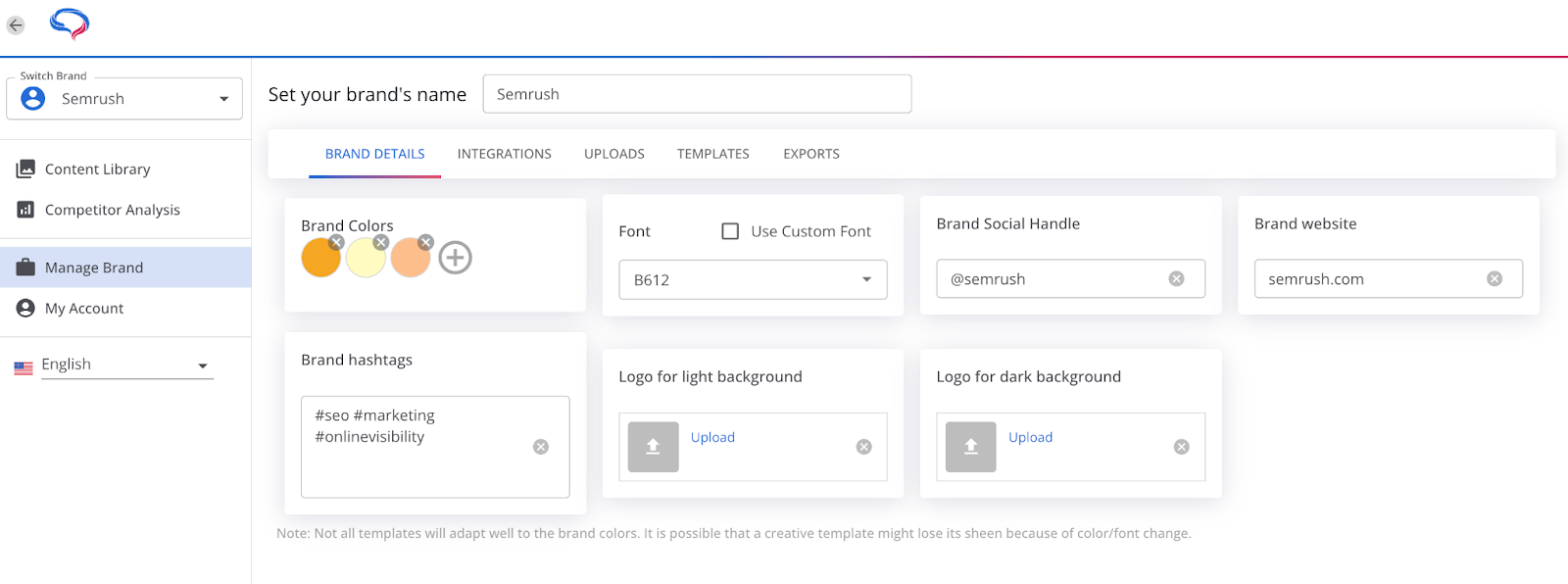
The Content Library then houses all of the social media content you’ve created. Here, you can create more content based on initial input, develop new content based on additional input, add hashtags, edit, organize, download, and more.
The Competitor Research section follows your competitors and provides details about each one, including their content topics, most successful content, hashtag selections, and general patterns.
Here, you gain a number of insights that can inform your B2B social media strategies, like post engagement based on the time of day and the top-performing posts overall.
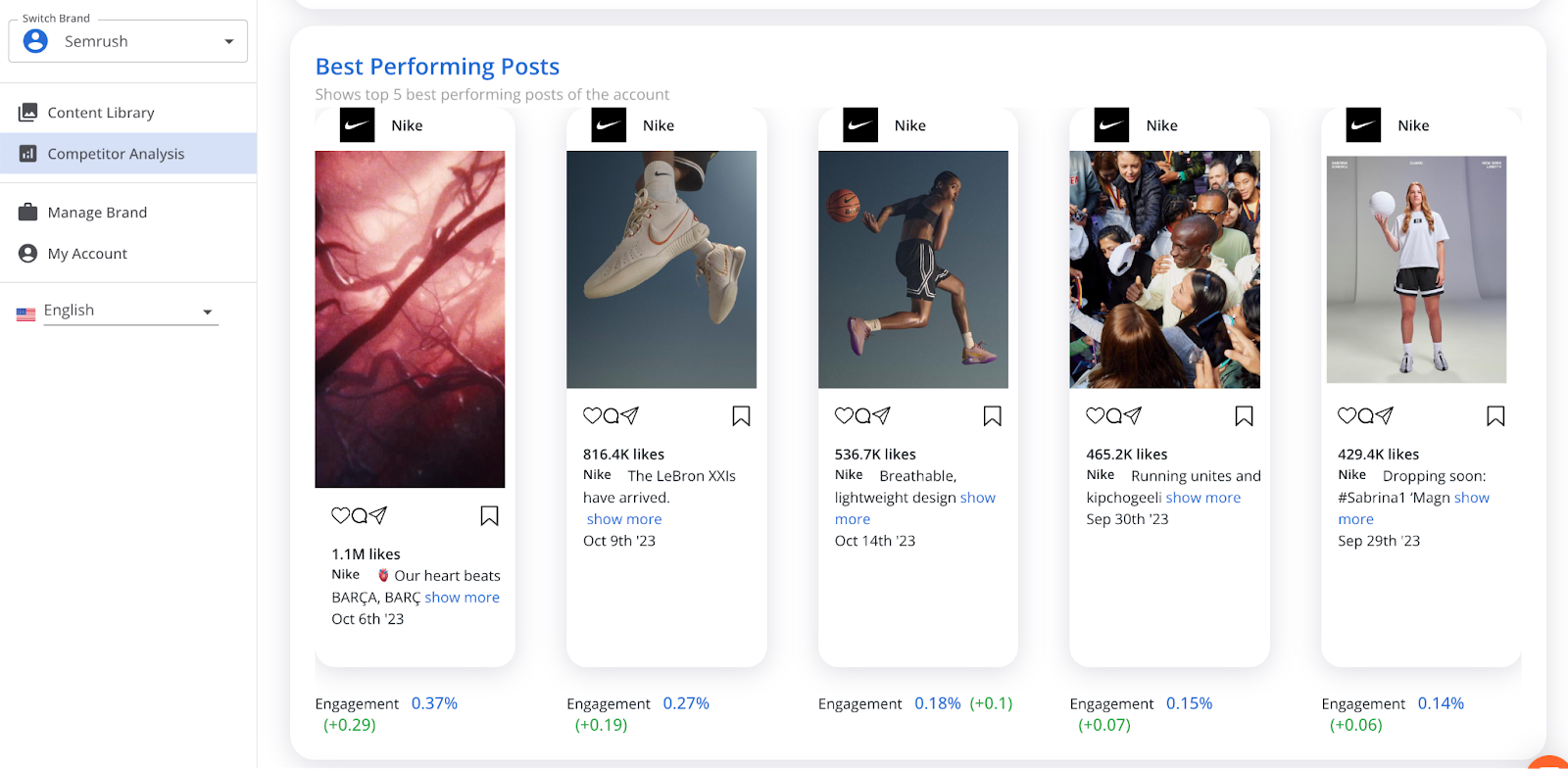
With the AI Social Content Generator insights and tools, you’re well on your way to creating image-based and video content that not only engages but also resonates with your audience, ensuring that your brand’s voice is heard loud and clear across the social media landscape.
4. Go Beyond Posting: Engage in Social Conversations
If it’s not apparent by now, engagement is central to social media marketing. This means it’s about more than just posting content, it’s about participating in conversations that resonate with your audience.
Be the brand that people want to talk to, and talk back to them! Replies and comments are another touch point with your customers, so give them another reason to choose you over the competition. Have fun with it!
Below are a few ways to effectively create and interact on social platforms.
Create Interactive Content
Don’t just broadcast to your audience. Instead, listen to them. Ask them questions.
Formats like live streams, polls, and surveys invite your audience to share their opinions, turning your page into a two-way conversation.
Manage Groups and Forums
Diving into online groups can boost your social media presence by fostering communities. Sharing your expertise, offering solutions, and engaging in discussions are great ways to build authority and trust within your industry.
Respond to Social Media Posts
This tip may be the most important. Engaging with posts demonstrates to your audience that you appreciate their opinions and are committed to fostering a conversation. Prompt and considerate replies can convert casual followers into devoted supporters of your brand.
Tools like Sprout Social or the Social Inbox in Semrush Social come in handy to keep track of all these interactions.
Social Inbox helps you monitor comments, messages, and mentions across Facebook, LinkedIn, and Instagram without ever leaving the Semrush interface, ensuring you never miss an opportunity to engage on these platforms.
The tool also allows you to categorize and prioritize incoming communication, ensuring that your tasks remain well-organized and up-to-date.
Another way to stay involved in the conversation is by setting up a mentions tracker tool, like Media Monitoring. This tool tracks the web for every mention of your brand name, so you can stay in the know any time someone’s talking you up or calling you out online.
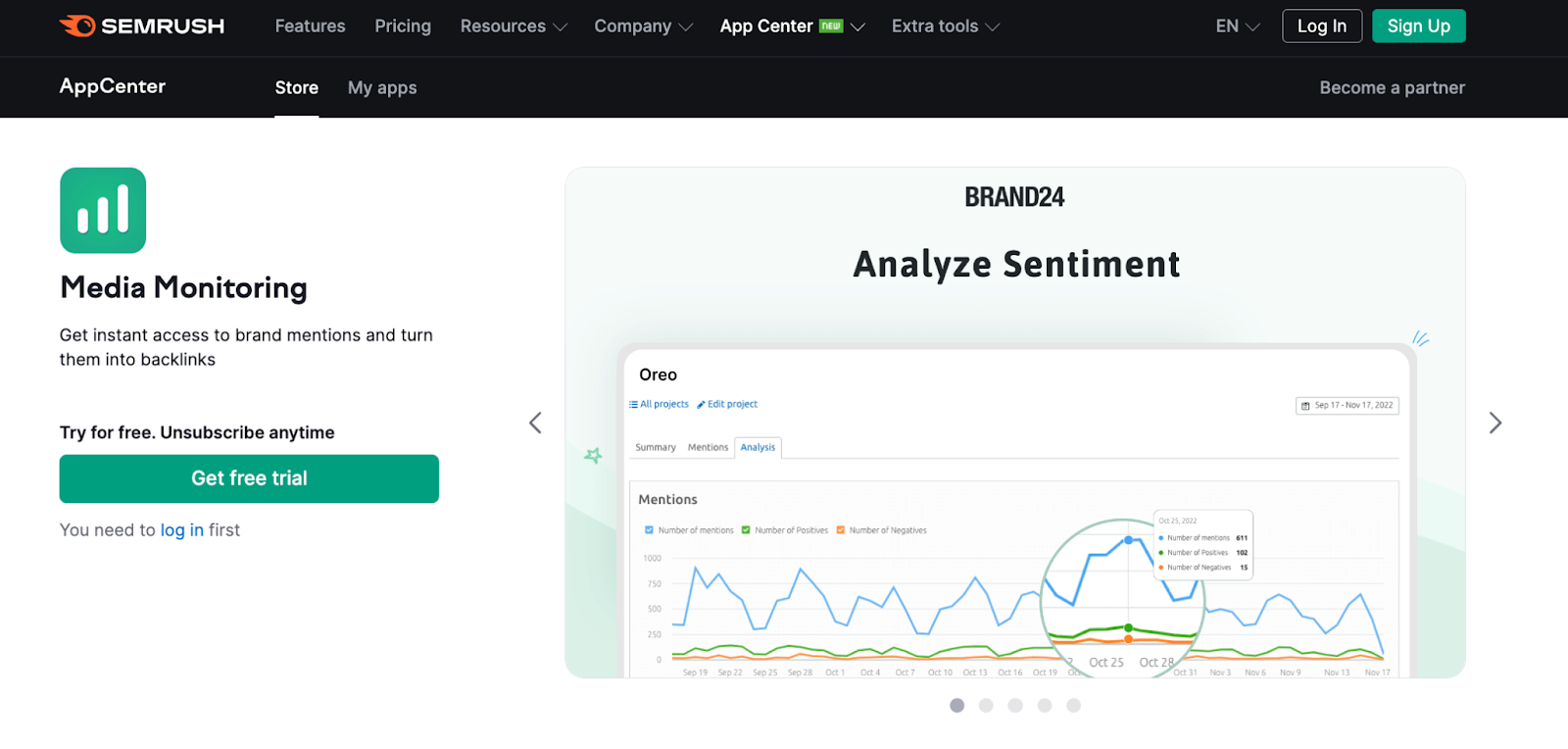
In other words, media monitoring is like the reputation manager that keeps your brand’s image in check.
In the Media Monitoring application, you can review metrics in the Summary, Mentions, and Analysis tabs. From the Summary tab, you can also connect with individuals discussing your brand, which presents valuable chances to establish backlinks, which could boost your brand’s SEO.
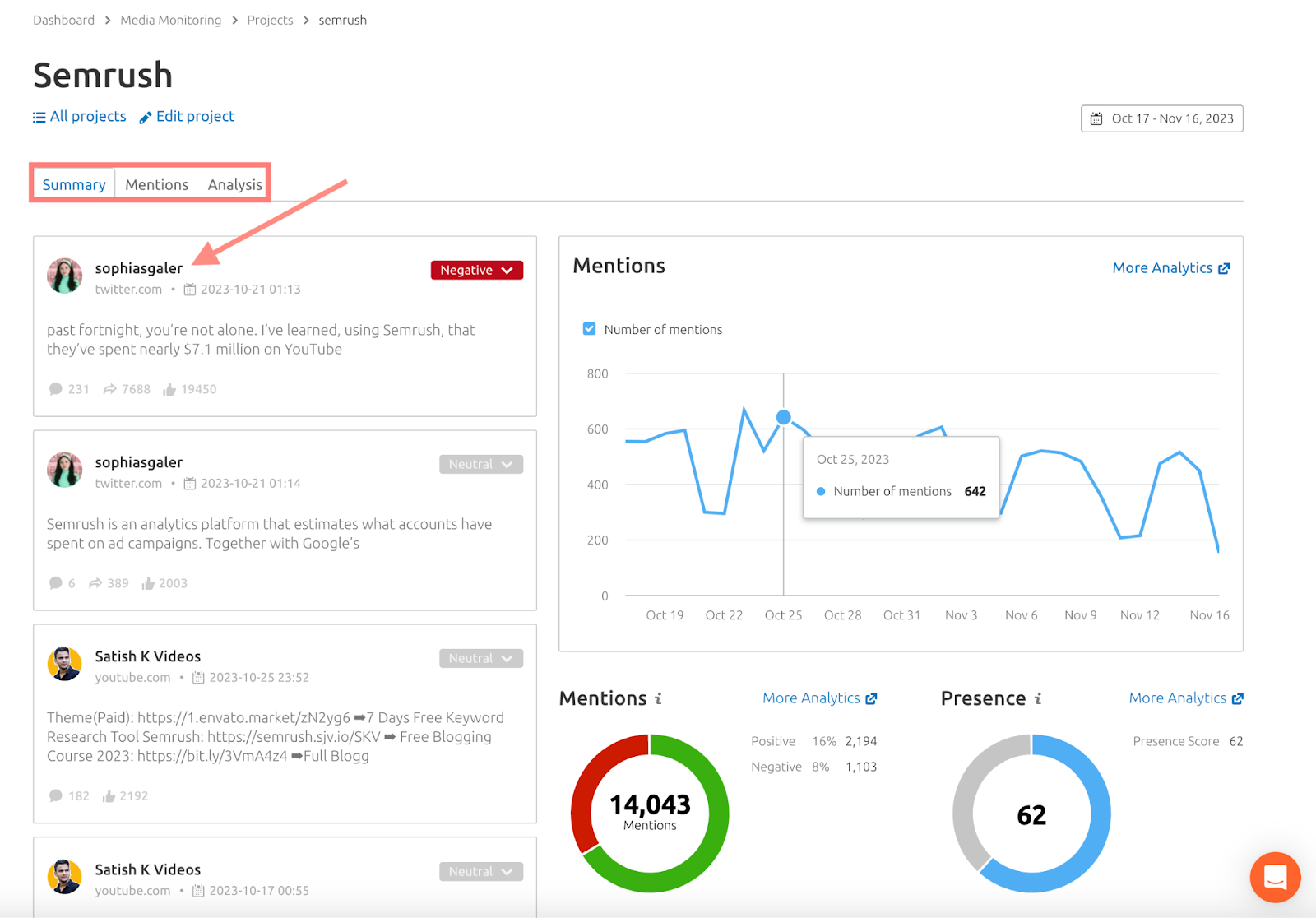
5. Consider B2B Influencer Marketing
According to Semrush’s 2024 Social Trends Report, partnering with influencers is set to be a key trend. This is because audiences trust influencers slightly more than direct brand influence since they’re not expecting a direct sale.
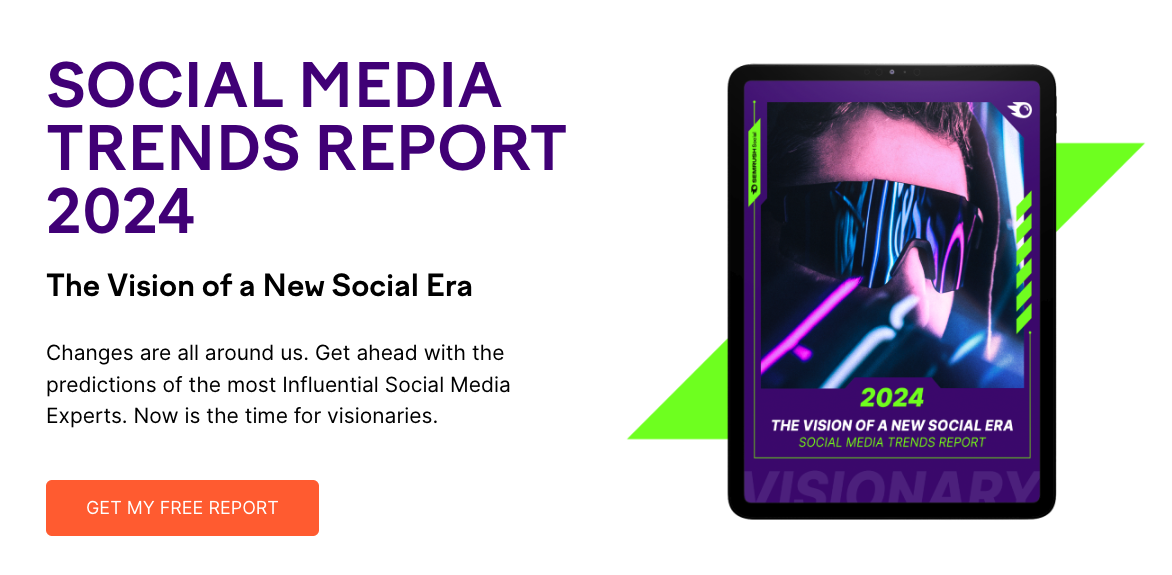
Therefore, the focus has shifted from merely counting on an influencer’s followers to establishing long-term collaborations with personalities who genuinely connect with your business’s values and can authentically narrate its story.
Partnering with real people who have gained the trust and respect of their audience and have built a community increases the chances of building more trust for your brand.
By identifying the right influencers and co-creating content tailored to each influencer’s audience, you can define your business’s unique value and personalize the advertising process.
Apps like Influencer Analytics in the Semrush App Center can help you get started with influencer marketing, from discovering who might be the right fit to campaign management and competitor analysis.
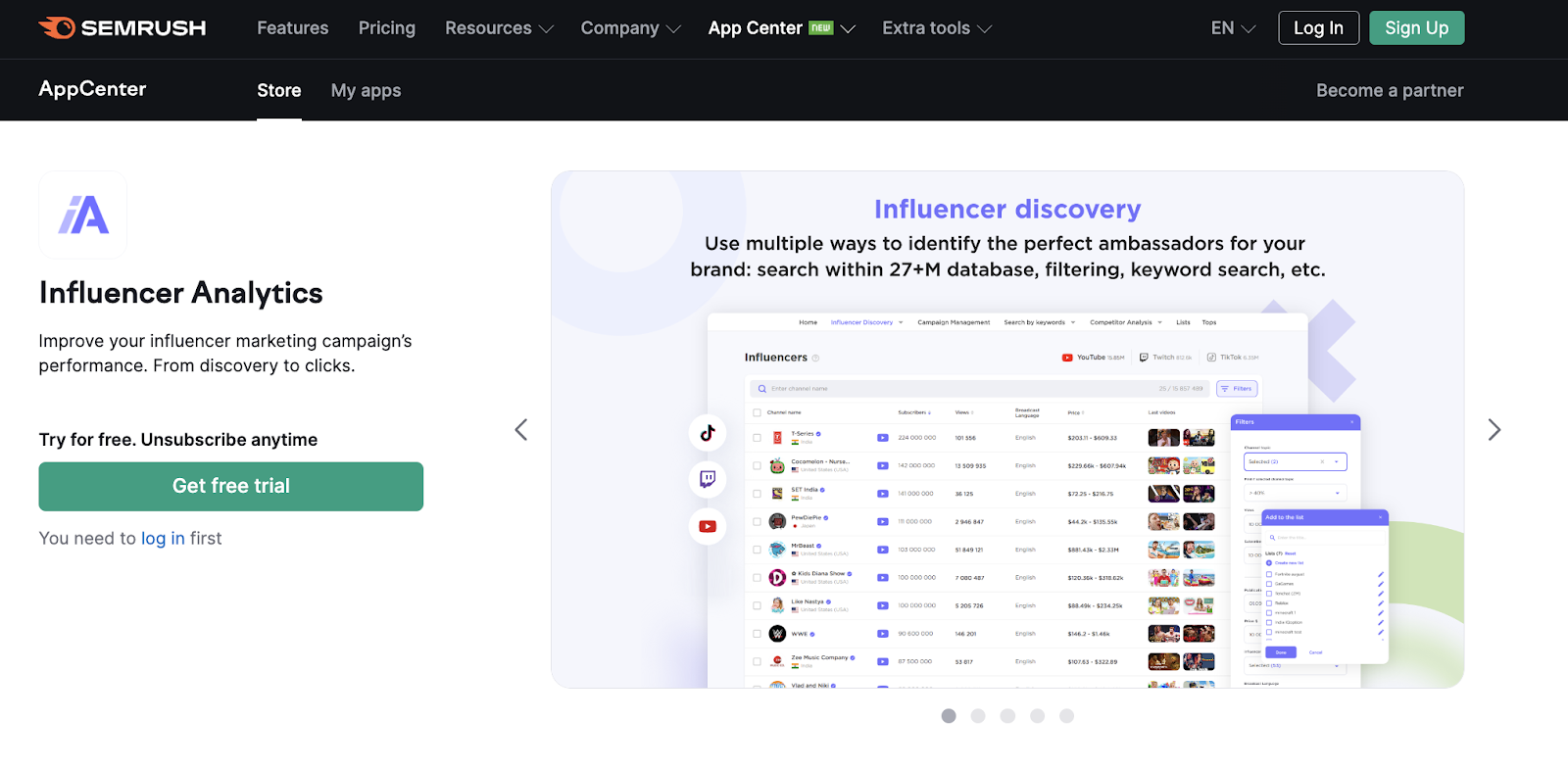
Leveraging these tools can strengthen your brand’s message and increase visibility in a competitive market.
Let’s go over a quick workflow on how to use it to find the right influencers to partner with.
How to Find Marketing Partners with Influencer Analytics:
The app’s main window is divided into tabs that allow you to research and strategize influencer relationships on TikTok, YouTube, and Twitch.
To find potential influencer matches, click Influencer Discovery and choose your platform.
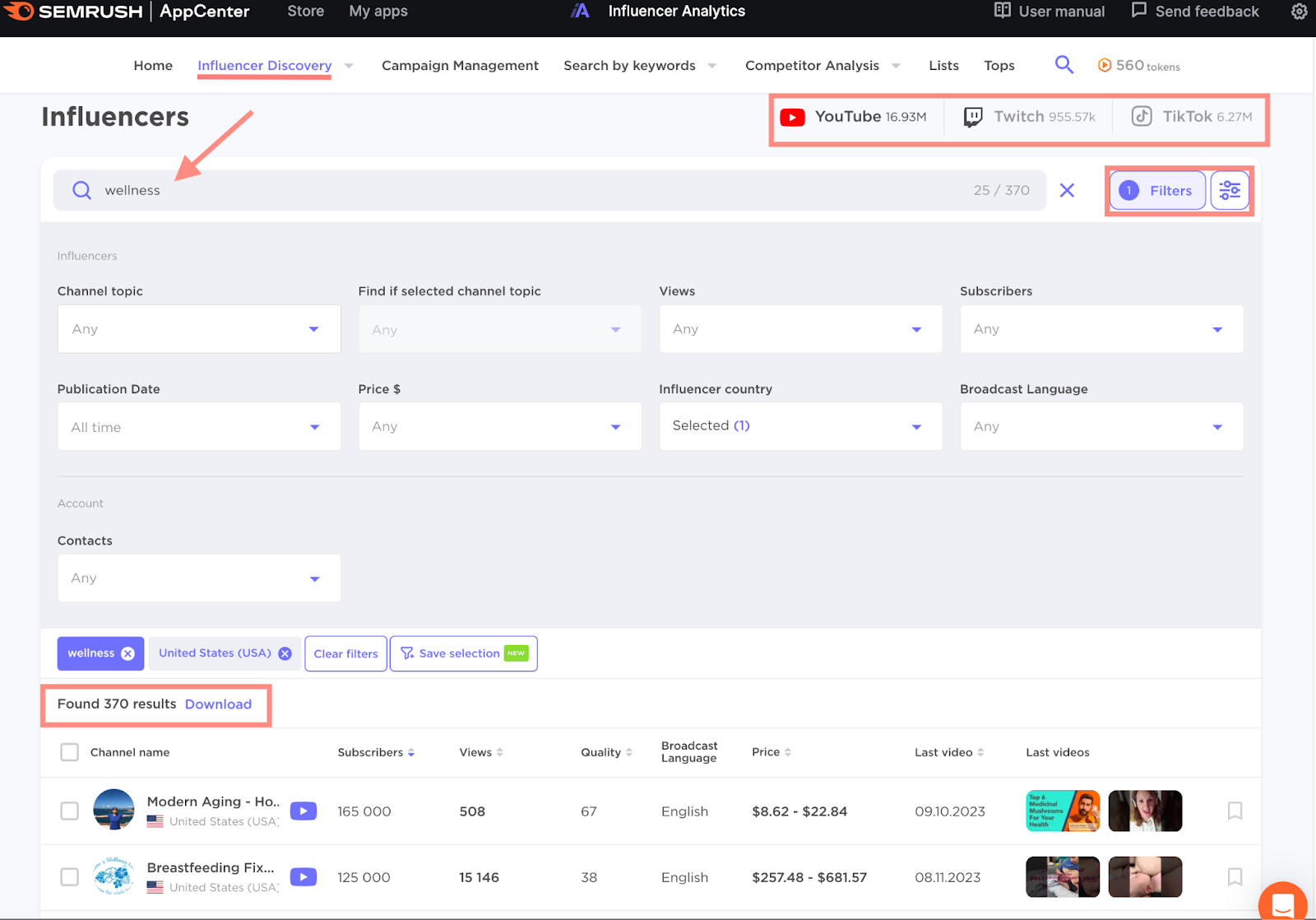
Here, you can search by channel name or topic and use various filters to narrow your search. In the resulting list, you can navigate to the profile of interest or add it to a list to be reviewed later.
The Campaign Management tab allows you to build and execute campaigns with social media influencers. In addition, you have the option to access and create new folders and ongoing campaigns to assess past projects.
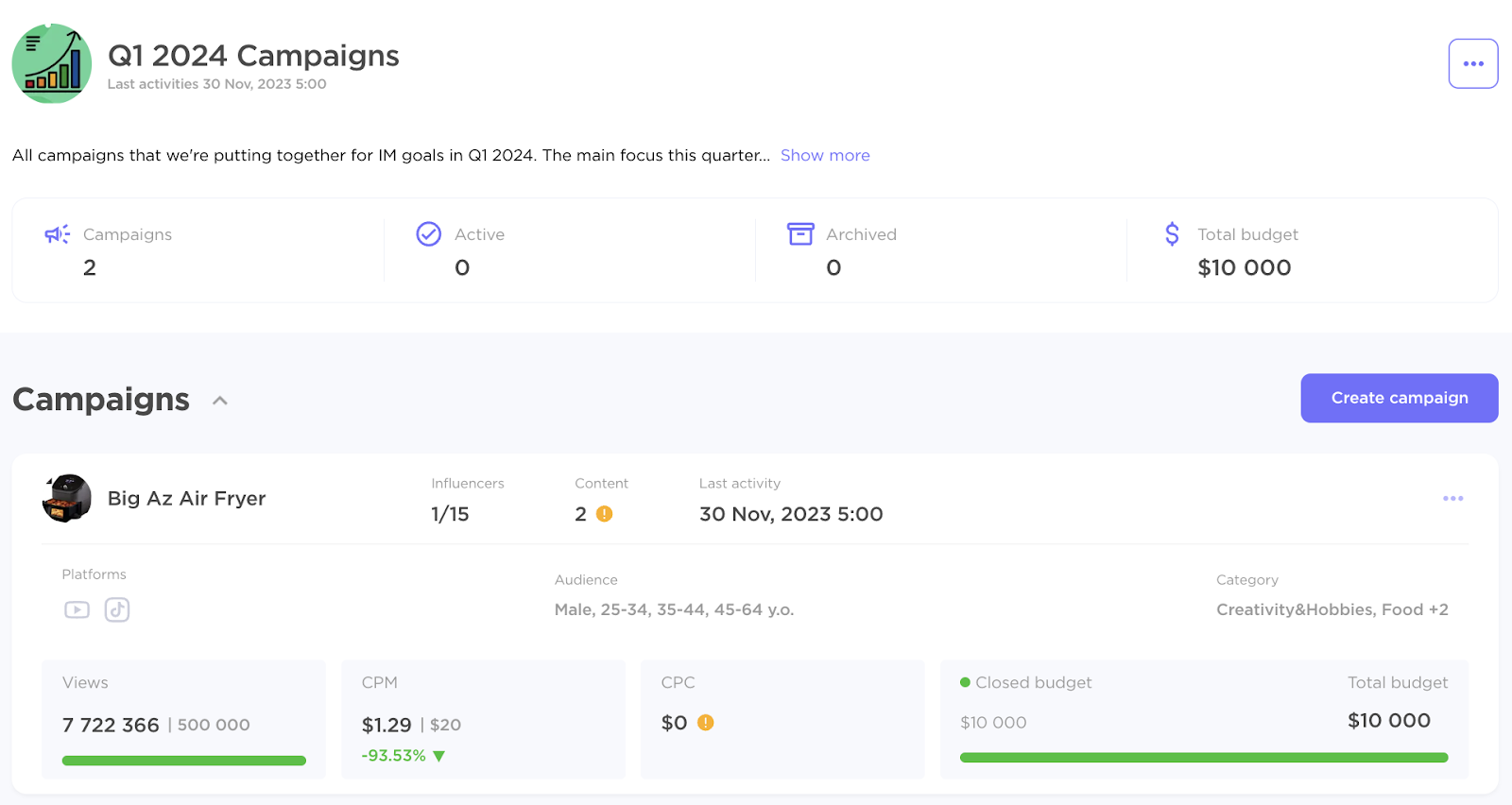
In the Competitor Analysis tab, you can explore competitors that are using influencers to market their brands or apps.
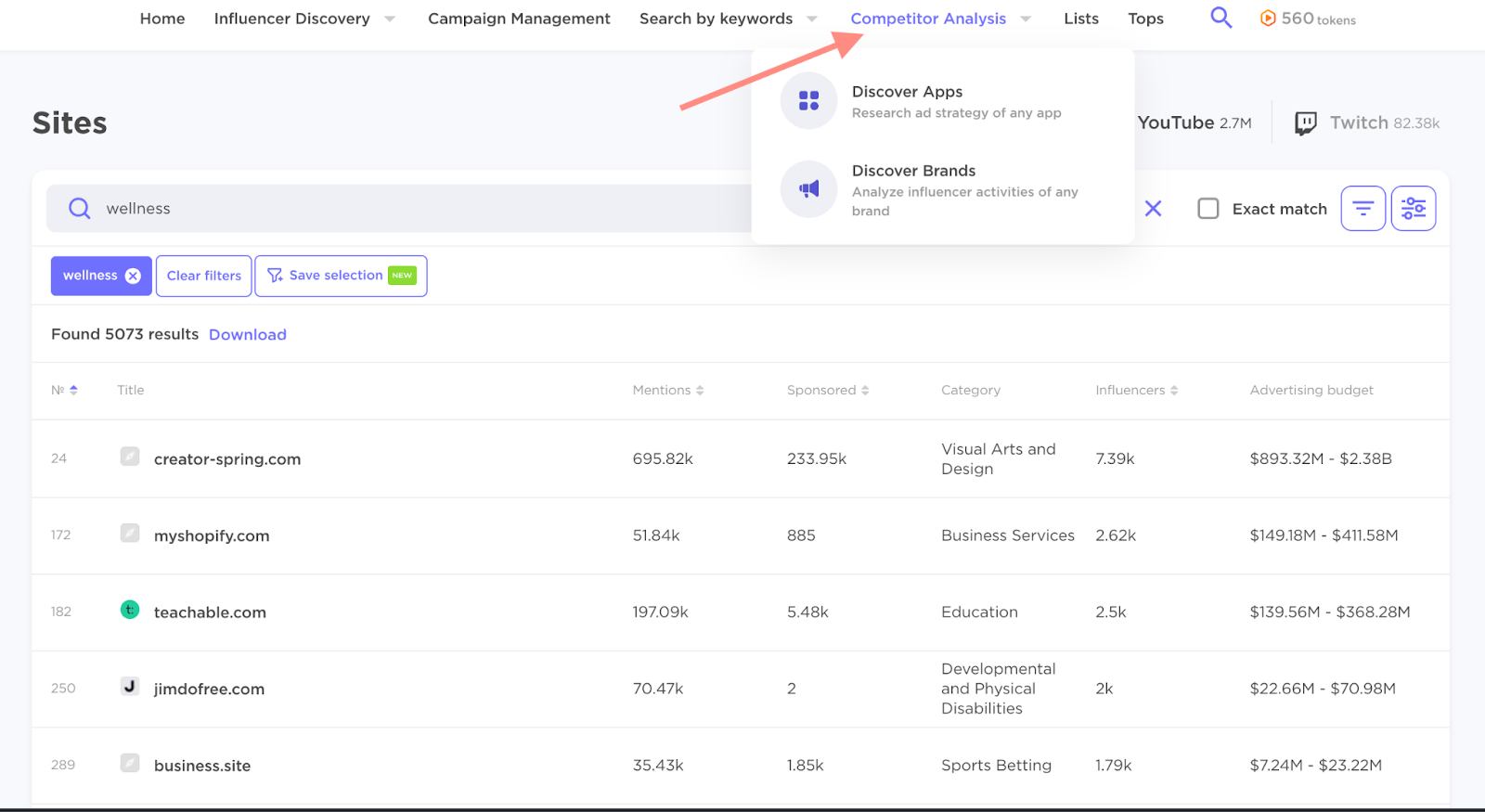
Clicking on the app or brand of interest will take you to detailed reports on the total number of influencer mentions, total views, and the approximate advertising budget.
Collectively, this information provides direction on how to structure your own social media marketing campaigns by unveiling what’s working (and what isn’t).
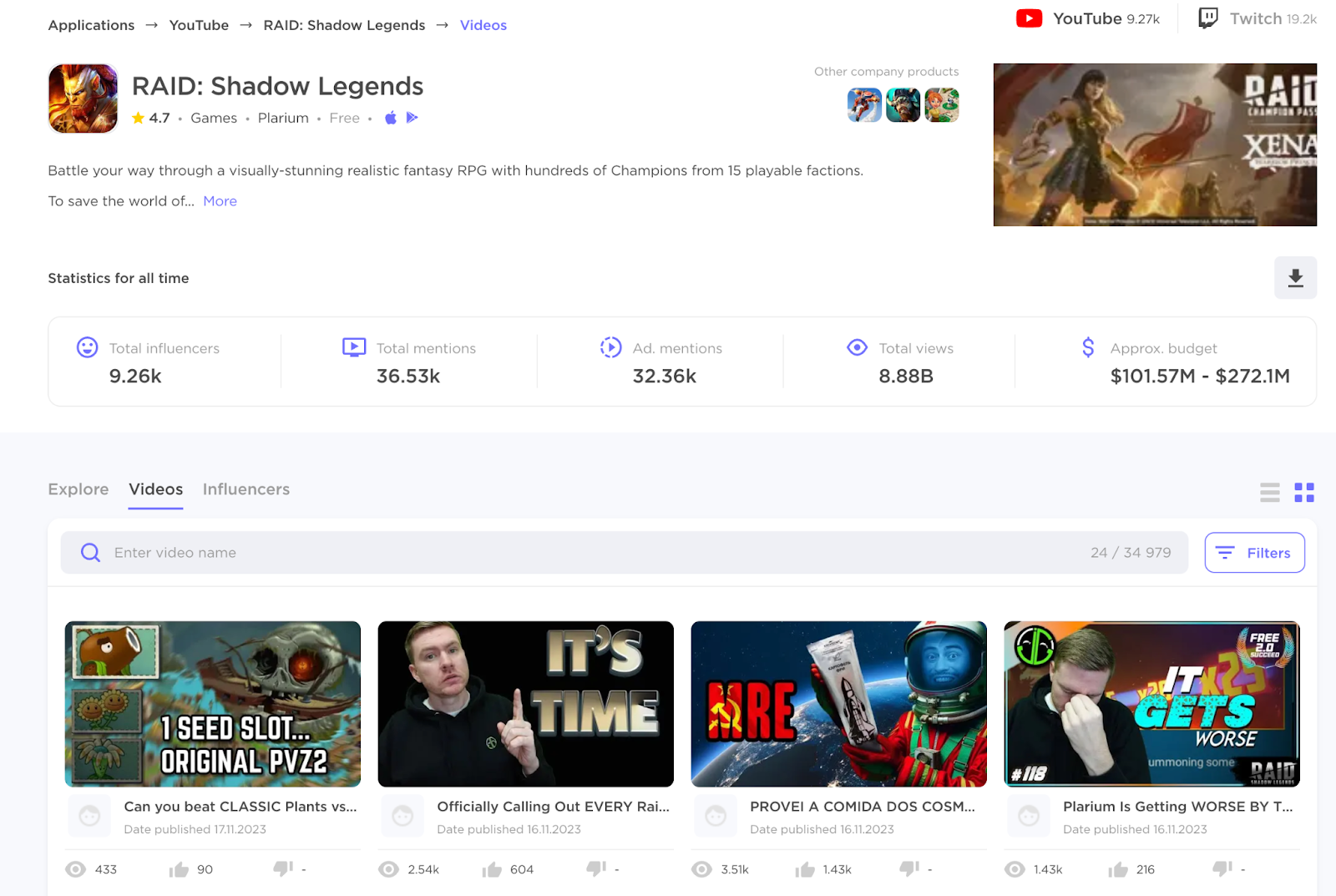
We’ve already explored a variety of Semrush tools and apps that will streamline your B2B social media marketing efforts, so let’s do a quick recap.
Semrush Social
Semrush Social facilitates social media marketing management through the following tools:
These tools allow you to schedule posts, track their effectiveness, compare your progress with rivals, and enhance communication with users.
Pricing: Semrush Social has a 7-day free trial. After the trial ends, it is treated as an add-on to your Semrush subscription, costing $19.75 monthly. You can find Semrush Social on the main platform and in the App Center.
AI Social Content Generator
AI Social Content Generator is an app that leverages AI to quickly create and edit brand-specific images, videos, memes, and copy.
Pricing: After a free trial, the AI Social Content Generator has two pricing options at $35 and $55 per month. The higher-tiered subscription allows for additional brand management, posts, and competitor analysis each month.
Audience Intelligence
With Audience Intelligence, you can better understand your audience’s online behavior, enabling you to develop a more impactful social strategy that yields tangible results.
Pricing: The Audience Intelligence app is available from the App Center for $150 per month for one report per month. Additional reporting can be purchased within the app.
Influencer Analytics
Use Influencer Analytics to discover potential collaborators, assess their performance, and gain data-driven insights into your competitors’ influencer marketing strategies.
Pricing: After a free trial,Influencer Analytics has several subscription levels:
- Basic plan: $169 per month
- Competitor Analysis: additional $129 per month
- Campaign Management: additional $69 per month
But these aren’t the only tools that can drive your B2B social media marketing strategies toward success.
Sprout Social
Sprout Social is a tool for managing social media platforms and gathering useful reporting information for all sizes of businesses. Sprout Social also helps servers as a community management tool that aids in keeping track of conversations and responses.
Pricing: After a free trial, Sprout Social has tiered pricing beginning at $249 monthly for a Standard subscription. Other subscription options include Professional ($399+), Advanced ($499+), and Enterprise (contact for pricing).
RivalIQ
RivallQ provides social media analytics and competitor analysis to marketers worldwide. RivalQ also offers insights that allow users to adjust social media strategies based on working trends.
Pricing: RivalQ offers a free trial followed by the following options:
- Drive: $239/month
- Engage: $349/month
- Engage Pro: $559/month
Google GA4
Google Analytics (GA4) is Google’s free tracking service for your website that can also be used to track social media campaigns across platforms.
Pricing: Free!
Google Trends
Google Trends is a free keyword research tool that reports the popularity of regional search terms or industry trends over time. This is a great place to start when deciding your market strategy.
Pricing: Free!
Canva
Canva is an online graphics design tool that can assist with creating social media images and illustrations.
Pricing: Canva is accessible for limited use for free, which may suit some users. Other subscription options include Pro (starting at $14.99/month) and Teams (starting at $29.99/month).
BuzzSumo
BuzzSumo allows users to search for the content with the most engagement and highlights chances for outreach on social media and search engines. This information can help you create content that resonates with your audience, driving traffic and engagement.
Pricing: BuzzSumo offers a 30-day free trial followed by tiered pricing ranging from $199/month for Content Creation to $999/month for Enterprise.
Social media marketing can be a game changer for your business, but it can take time to get started for companies accustomed to conventional marketing methods.
Courtesy of our B2B social media marketing team, here are the best practices to follow:
- Set specific goals and match the message to the platform
- Offer genuine solutions with storytelling
- Be human and relatable
- Speak your audience’s language
- Respond promptly to comments
- Experiment and stay trend-savvy
Set Specific Goals and Match the Message to the Platform
Every post should have a distinct purpose tailored to the platform you’re using. Whether it’s LinkedIn for thought leadership or Instagram for visual storytelling, align your content’s goal with the platform’s strengths.
Offer Genuine Solutions with Storytelling
Instead of merely promoting products, tell stories that highlight how your solutions address real-world problems. Storytelling can make your brand more relatable and help illustrate the value of your offerings.
People don’t want to read about your company: they want to read about their problems and how they can solve them in an easy way. When you nail that, you offer genuine solutions.
Be Human and Relatable
Avoid overly formal tones. Instead, be approachable and authentic, use humor (appropriately), and show your brand’s personality. Relax, and let your genuine persona shine through.
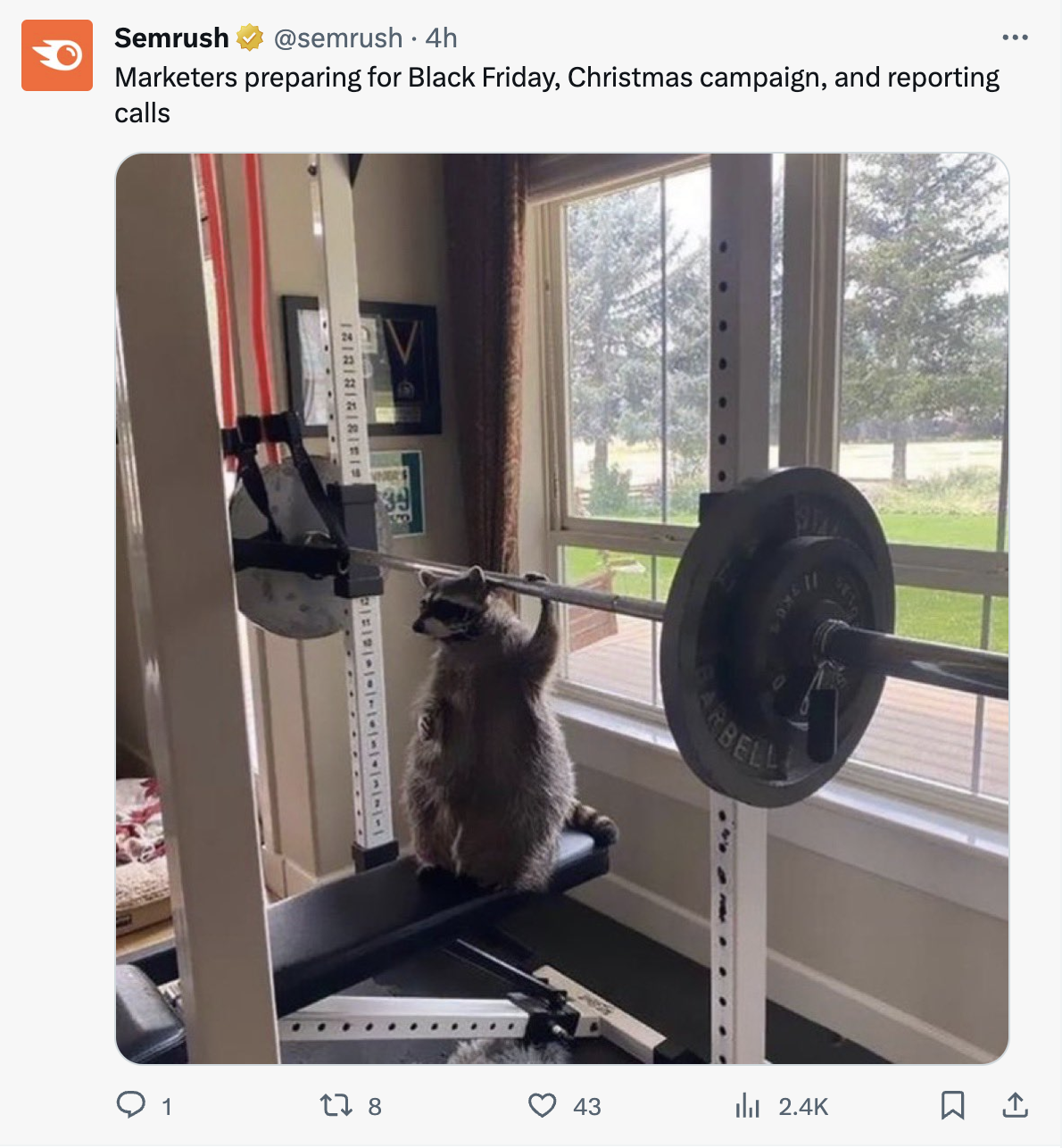
Read your content and imagine if this is something you would say out loud in real life. If not, then nobody in real life will probably care to engage either.
Speak Your Audience’s Language
Adapt your messaging to resonate with your audience. Whether your audience prefers a professional tone or a more casual approach, mirroring your audience’s communication style can create a stronger connection.
This is especially important when responding to customers on various social media platforms. For example, it is less appropriate to reply to a negative remark with a humorous image or to respond to a joke with a formal tone. Take a moment to understand the intended tone.
Respond Promptly to Comments
Nearly 70% of consumers anticipate a reply to their comments or questions within 24 hours, yet most companies are not delivering. Simply going beyond posting content to responding to comments and messages shows your audience you are listening.
This two-way interaction fosters a sense of community around your brand and provides inspiration for new content ideas and creative strategies.
If you need help prioritizing, start by replying to negative comments first. By politely acknowledging complaints, you promote open communication, often resulting in quick resolutions.
Negative comments might be easy to ignore, but don’t shy away from them. Step up and take action. Encourage them to contact you privately, through DMs or Customer Support, with more information about their account and experience. Investigate. Ask questions. Find a solution.
Experiment and Stay Trend-Savvy
Playing it safe isn’t always the best strategy in social media. Consider implementing the 20/80 rule in your content strategy. Dedicate 20% of your efforts to experimenting with new trends and formats and the rest to proven tactics. This balance keeps your strategy fresh and adaptive. However, keeping up with trends should not overshadow the quality of your content.
Staying on top of trends is great, but delivering quality content is even greater. Be mindful that the internet changes every millisecond; it’s better to work on ideas and partnerships that can be relevant and everlasting.
With the right tools and tactics, you’re not just reaching out to potential customers by marketing with social media, you’re creating a compelling brand story and building lasting relationships.
Not each experiment will be a success, but give it at least 2 weeks and 2-3 posts before deciding if this is something you want to start or stop doing. If it’s successful, incorporate the new experiment in your overall strategy: now you have numbers to back it with.
Remember, you don’t need to be a social media marketing expert to get noticed on social media; you just need the right tools in your toolbox.
Try out a free trial of Semrush and check out the App Center to see if these tools are right for your social media strategy.
منبع: https://www.semrush.com/blog/b2b-social-media-marketing-strategies/